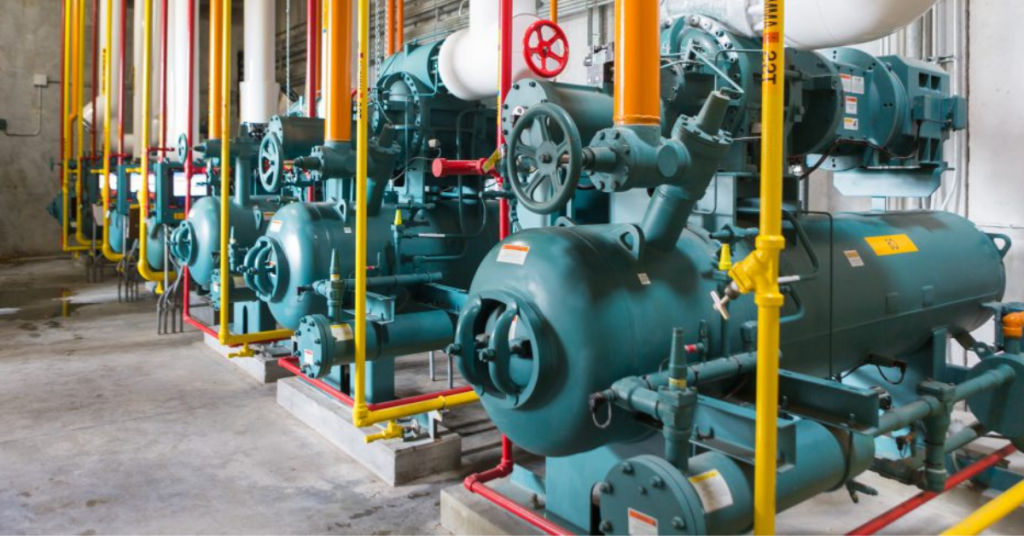As any industrial engineer will tell you, screw compressors play a vital role in the food and beverage industry, where temperature control is critical to ensure product safety and quality.
They’ll also tell you that these compressors require a lot of oil to work properly. This oil serves several functions, including sealing the rotors, lubricating the bearings and cooling the discharge gas. Because of this, nearly all food processors and beverage manufacturers will be in the market for a refrigeration compressor rebuild or replacement at some point or another.
And while regular maintenance can help, designing a system with the proper oil-cooling technique can also extend a compressor’s lifespan by thousands of operating hours — but how do you determine what method makes the most sense for your system?
There are several oil-cooling techniques you can employ, each with its pros and cons. Choosing the right system depends on several factors, including the compressor size, cooling requirements and (of course) your operating budget.
In this blog post, we’ll discuss three common oil-cooling techniques used in industrial refrigeration compressors to help you select the right one for your application. By implementing the appropriate oil-cooling method, you can maximize your system’s lifespan and positively impact your bottom line.
Liquid Injection Oil-Cooling
Liquid injection oil-cooling involves injecting refrigerant liquid directly into specific compressor porting based on operating conditions; it then enters the discharge stream and flows directly into the oil separator. The liquid refrigerant absorbs the heat from the oil, thus reducing its temperature, and then circulates back into the compressor to continue the cooling process.
Liquid injection is not commonly employed in carbon dioxide (CO2) or R22 applications. Often, this technique can be found in ammonia refrigeration systems.
Advantages
- Liquid injection cooling can often be a much cheaper upfront investment.
- Liquid injection is a viable option when the other methods below are unavailable.
Disadvantages
- While controls for these systems have certainly improved through the years, liquid-injection oil cooling can also be a leading cause of compressor failure and operational problems if not monitored or properly maintained, as its bearings are exposed to liquid refrigerant. When the controls for these systems fail, large amounts of heat are produced, which can lock up compressors and, in some cases, melt the metal rotors.
- This method may not be suitable for smaller compressors or those with lower heat loads.
Water- or Glycol-Cooled Oil-Cooling
Water- or glycol-cooled oil cooling is a process that relies on a separate water/glycol circuit, often through a heat exchanger or oil cooler, to dissipate heat from the compressor’s oil. This approach effectively controls oil temperature and is versatile enough for a wide range of applications and compressor sizes, with the added benefit of reducing the chances of refrigerant contamination.
Advantages
- A major advantage of water-/glycol-cooled oil cooling is its compatibility across systems.
- This method is energy-efficient and can reduce energy consumption and operating costs if there is an accessible body of water nearby.
Disadvantages
- Water-/glycol-cooled oil cooling is often more expensive than liquid injection.
- Water-/glycol-cooled oil systems usually need to be located near accessible bodies of water to help offset some of the costs. Otherwise, sourcing large quantities of treated water can be extremely costly.
- Water treatment is necessary to prevent corrosion and bacteria growth in the water lines.
Thermosyphon Oil-Cooling
Thermosyphon oil cooling relies on natural convection and gravity to flood the heat exchanger, effectively transferring heat to another fluid like refrigerant or water. This method provides a low-maintenance, intuitively designed and energy-efficient solution for managing compressor oil temperatures.
Advantages
- Because thermosyphon systems use natural movement, they can significantly reduce energy consumption and operating costs compared to systems that rely on pumps.
- With fewer moving parts, thermosyphon oil cooling systems require less maintenance and are less prone to mechanical issues.
- The simple design of thermosyphon systems makes them easier to install and more straightforward to understand and troubleshoot.
Disadvantages
- Ensuring the correct orientation and positioning of the heat exchanger and compressor is essential for efficient thermosyphon operation, which can make the installation process a bit more challenging.
- The performance of a thermosyphon oil cooling system is closely tied to the temperature difference between the oil and the secondary fluid. Fluctuations in environmental conditions or fluid temperatures can directly affect the system’s efficiency.
Other Considerations
Switching from one oil-cooling system to another can be a significant undertaking, often requiring hundreds of thousands of dollars in construction costs. So once your system is in place, general wisdom (and the numbers that underline it) suggests sticking with what you’ve got.
But regardless of the oil cooling technique that supports your system, performing a thorough review of your compressor’s functionality annually can have long-lasting implications. There are many common mistakes and oversights when it comes to compressor maintenance, so during your audit, be sure to inspect:
- Relief valves
- Microprocessors
- Temperature probes
- Transducers
- Oil pumps
- The motor itself
- Pipe stress
Proper oil cooling is essential to maintain the reliability, efficiency and longevity of refrigeration compressors used in food and beverage plants. By choosing the right oil cooling technique, you can optimize the performance of your compressor and minimize the risk of downtime and costly repairs. Each method — liquid injection, water/glycol-cooled and thermosyphon — has its own set of advantages and disadvantages, making it crucial to consider your specific application and operational needs.
Partnering with an experienced firm like Stellar can help ensure that you implement the most effective oil-cooling solution tailored to your facility’s unique requirements.
Have questions about the best way to optimize and maintain your compressors? Email us at foodforthought@stellar.net or give us a call at 800.488.2900.



